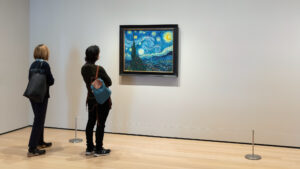
“The Starry Night” – Painted by Vincent Van Gogh in 1889
People viewing the “Starry Night” in the Museum of Modern Arts,
Leopold Kory Song
The Significance of the Starry Night
“Starry Night” is one of the best paintings ever created, beloved by so many people. This makes it even more interesting that Vincent Van Gogh painted it when he was admitted to the Saint-Paul-de-Mausole asylum in Saint-Remy-de-Provence, France. The Painting was famous for its unique brushstrokes and exaggerated yet beautiful perception of the night sky.
How did the Museum of Modern Art acquire such a piece?
The Starry Night was not valued as much as it is today. In the original Van Gogh exhibition in New York, which lasted from November 5, 1935, to January 5, 1936, the Painting arrived too late and missed the opportunity to be seen by over 900,000 people in the United States.
One year after the death of Vincent Van Gogh, Jo van Gogh-Bonger received the Starry Night painting. The Starry Night went through several owners until it was sold to the Oldenzeel Gallery in Rotterdam. The Painting was sold to Georgette P. van Stolk. Then George P. van Stolk sold it to the Paul Rosenberg Gallery. The Paul Rosenberg Gallery sold Starry Night to the Museum of Modern Art in 1941. Lillie P. Bliss helped acquire the Painting by selling three paintings that Lillie P. Bliss had acquired previously. Lillie P. Bliss and Jo Van Gogh-Bonger played crucial roles in getting Starry Night into its current place today. Currently, the Painting is in the Museum of Modern Art.
Who was Lillie P. Bliss?
Lillie P. Bliss (Lizzie Plummer Bliss) was born on April 11, 1864, in Boston, Massachusetts, United States. She is known by many for being the Museum of Modern Art’s founding member and a crucial figure in obtaining many paintings for the Museum of Modern Art. Her paintings, such as “Starry Night,” were obtained through her assistance and supervision. One hundred fifty works of art by various artists in the 19th and 20th centuries were from Mrs. Bliss’s collection when donated to the Museum of Modern Art’s home collection. In 1941, she sold three artworks from her collection to obtain the “Starry Night” from the Paul Rosenberg Gallery.
How did the “Starry Night” represent the Museum’s purpose?
The “Starry Night” is an iconic piece of Painting, which is why the fact that the Museum of Modern Art obtained such a fine piece makes the Museum exciting and educational. These characteristics and the ability to obtain such paintings strengthen the Museum’s purpose. Starry Night became MoMA’s most famous artwork and continues attracting millions of tourists worldwide. This helps the Museum’s purpose of being educational and preserving fine artworks.
What is the cost of the Starry Night?
If the Starry Night artwork were to be sold today, on March 20, 2024, it would cost around $100 million. However, the Museum of Modern Art doesn’t intend to sell such artwork yet.
Challenges of getting the Starry Night
There were considerable challenges as Starry Night went through many owners before finding its current home at the Museum of Modern Arts. However, the Museum of Modern Art had some challenges acquiring the Painting. I think the most crucial part is that Starry Night had a big journey as it traveled to many homes and sold many times before being displayed in its home at the Museum of Modern Arts. A notable challenge of the Museum of Modern Art trying to obtain the Painting would be getting the necessary funds to purchase the Painting from the Paul Rosenberg Gallery. Thanks to Lillie P. Bliss, the Painting is now home in New York, United States.
Factors in play in displaying the Starry Night
Only some factors were put into play to correctly display the Starry Night. Factors include lighting, as the visitors must be able to see the Starry Night in all of its glory. There is also an issue with security as some protestors may pour soup over the Painting, which is why protective measures are implemented. One such example is adding a plastic cover layer to protect the Painting from such attack. Crowd management is another huge factor to consider because many tourists want to visit the Starry Night, so tickets are sold in advance for guests who wish to see the Starry Night in New York.
Sources:
chrome-extension://efaidnbmnnnibpcajpcglclefindmkaj/https://www.moma.org/momaorg/shared/pdfs/docs/press_archives/739/releases/MOMA_1941_0076_1941-09-29_41929-75.pdf
https://en.wikipedia.org/wiki/Lillie_P._Bliss
https://www.moma.org/collection/works/79802
https://www.artandobject.com/news/starry-night-takes-center-stage-van-goghs-cypresses-met#:~:text=The%20painting%20was%20then%20sold,the%20collection%20of%20Lillie%20P.



 Posted in
Posted in 

